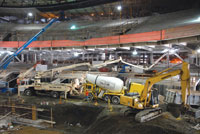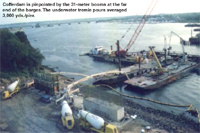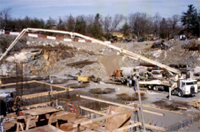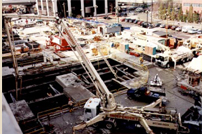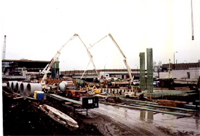projects

Brayton Point Cooling Towers
Somerset, Ma

Brightman Street Bridge
Somerset, Ma

Bunker Hill Monument
Charlestown, Ma

Yale Water Chiller
New Haven, Ct

MGM Casino
Mashantucket, Ct
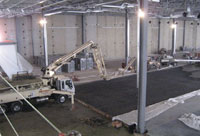
Walgreens Distribution Center
Windsor, Ct

Hatfield Reservoir
Hatfield, Ma
Unique Pump Puts Foxwoods Casino Addition on Fast Track
A unique telescopic boom concrete pump is helping to speed the $750 million expansion of New England’s Foxwoods Casino. In a first-ever arrangement, MGM has agreed to license its name to the Mashantucket Pequot Tribal Nation for the addition to this existing casino near Hartford, Connecticut. Independent Concrete Pumping, Wakefield, Massachusetts is working extensively on the project for General Contractors J.L. Marshall & Sons, Inc., Pawtucket, Rhode Island.
“We are using the pump almost everyday, but it has been an absolute necessity on the theatre and casino floors,” explains Ken Marshall, fourth generation owner and longtime customer of Independents. The theatre is a 5500 seat venue with tiers which had to be pumped from an enclosed area. The arc of the seating area measures 225-feet. A narrow set-up area followed the curve of the arc and was bordered on one side by the seating and by an excavation on the other side. “This was as challenging of a pump job as you get. It’s indoors, you’ve got limited room to maneuver the boom and you are trying to reach under the ceiling to pour the top tiers,” according to John Wulforst, Marshall’s superintendent on the project.
The concrete pump is the Schwing S 31 XT with a telescopic first section. “If we could only have one pump it would be this one,” states Jim Toothaker, Independent owner, “It can maneuver into configurations no other boom can and telescope straight in or straight out on a complex pour and then go out on a house foundation the next day and pour like a regular boom.” Independent operates a fleet of 25 truck-mounted concrete pumps from 17 to 52 meter boom lengths and a fleet of trailer pumps.
“It requires a lot less labor when you can stick the end hose into these tight spots, “Wulforst adds, “In this case the overhead clearance was not an issue as much as the ability to maneuver the boom up under the top tiers. I’m not sure how we could have done this job any other way. We didn’t want to run slickline because of the combination of vertical and horizontal runs required to reach all of the areas.”
In practice the operator would configure the boom and use the 15’2” of telescopic action to boom up the four levels of seating. This point and shoot method was used to swing through the arc of the semicircular theatre seating from one location. Good planning and strategic positioning of the pump with its 545-degree boom rotation allowed the crew to accomplish four pours from one set-up.
Overall production was been sufficient to keep the project on schedule but short of the telescopic pumps 170 cubic yard per hour output. “The owners expect a fast track pace because of the millions of dollars of revenue that can be generated daily once the facility opens,” Marshall noted, “The telescopic pump has been a key to keeping the indoor work moving quickly.”
The pump’s ability to unfold in only 18’8” really paid off on the casino floor where only 22-feet separated the bottom of the joists from the slab. “We used the telescopic pump with a laser screed to pour more than 500,000 square feet of slab on grade,” explains Marshall. The owners required a FF 72 flatness specification for the ballroom floor.
The casino floor where slot machines are positioned was poured in two lifts. First a 4,000 psi slab was pumped with the telescopic boom action keeping the end hose positioned in front of the walk-behind laser screed. The operator was able to use the Vector controls with proportional joystick action to good use. In addition the Vector remote box provided digital readout of important operational data such as hydraulic oil pressure, strokes per minute and hydraulic oil temperature that are useful to fine tuning the controlled output of the pump. “An operator will listen to the sound of a pump and notice immediately any change,” Toothaker explained, “But in an enclosed structure it can be harder to hear and the Vector system can really pay off.”
The slab varied in thickness from four to eight inches. Then a three-inch topping slab was poured around more than 500 6”x9” boxes that contain the electrical connection for each gaming machine. “There’s no way we could have dragged three-hundred feet of slickline over these sensitive areas, “Wolforst claims. In a testament to the precision placement of the boom and a great finishing crew, the end result is “an eighth inch of cream over the top of each one of those boxes,” according to Marshall, ”The installers have easy access to the boxes and the machines sit on a super flat floor.”
Foxwoods is the largest casino in the world, with 340,000 square feet of gaming space in a complex that covers 4.7 million square feet. More than 40,000 guests visit Foxwoods each day. By the summer of 2008, the resort will add nearly 2 million square feet of overall space, featuring significantly increased hotel, entertainment, restaurants and gaming venues as well as enhanced corporate retreat, meeting and convention resources. The project will also positively impact the local employment landscape, with 2,300 new jobs expected to be generated.
Specs:
Owner: Mashantucket Pequot Tribal Nation
Developer/Architect: Foxwoods Development Company
Subcontractor: J.L. Marshall & Sons, Inc., Pawtucket, Rhode Island.
Pumping Contractor: Independent Concrete Pumping, Wakefield, Massachusetts
Equipment: Schwng S 31 XT telescopic boom truck-mounted concrete pump
Top
Baldwin Bridge
Footings, Piers and Precast Deck All Pumped for Connecticut Span
Concrete pumps are working to an early completion of the all-concrete Baldwin Bridge, the first segmented bridge in Connecticut and -- at $94 million -- the state’s largest-ever single construction contract. In addition, a pump was used to pour the precast segments for the superstructure of the 2,520-ft.-long structure.
Spanning the Connecticut River on Long Island Sound between Old Saybrook and Old Lyme, the structure replaces a narrow bridge, and will carry traffic in both directions for I-95.
The prime contractors comprise a joint venture of Perini Corp., Farmingham, MA;PCL, Edmonton, Alberta; and O&G Industries, Torrington, CT, under the construction management of Parsons Brinckerhopp Construction Services. Work began in early 1990 under a four-year contract. The new bridge will carry four 12-ft travel lanes and two 12-ft emergency lanes in each direction, plus a 9-ft west-bound pedestrian walkway.
Pumping at two sites Subcontractor Independent Concrete Pumping Corp., Wakefield, MA, alternated five Schwing truck-mounted concrete pumps with placing booms at the bridge site, and standby pump that was neverneeded. At a casting yard two miles from the bridge, a sixth Schwing pump poured 488 precast box-beam segments. Concrete pumps were responsible for the placement of all ready-mix in the 102,000-cu yd all-concrete Baldwin Bridge.
After pouring footings for the first land pier, Independent Concrete Pumping used its on-shore pumps to feed a pair of barge-mounted boom pumps that tremie-poured the cofferdam for the footing of the first river pier. The operators extended the placing booms of the two on-shore Schwing 1200-36 units to a pair of parallel barges thateach carried a Schwing truck
pump, stabilized by outriggers. The on-shore units pumped concrete through 150 ft of slickline to the non-pumping 1200-31 pumps that directed concrete flow to the 40 x 150- ft cofferdam. A hydraulic lifting crane on a third barge drove cofferdam sheetpiling. Project is heavy on piling Pier foundations required friction piles through sand within the sheetpiled cofferdams of Piers 2 through 6, and bearing pile hammered to rock for Piers 7 and 8. Supporting the heaviest load, Pier 6 required over 300 piles. Piling was driven both vertically and battered, and carries a design load of 100 tons. In all, 1,800 HP14X89 were driven for pier support.
Independent Concrete Pumping placed all foundation concrete, including the material for Pier 9, a caisson foundation, 14 x 550 ft, grouted 20 ft into bedrock. Pier 10 is the opposite-shore land structure.
Work on the river piers was done from a string of barges locked end to end and spudanchored to create a roadway for ready-mix trucks. The barges extended for 1,940 ft from the shore to Pier 8. The channel between Piers 8 and10 (on land) remained open to river navigation.
Independent mixed its pump fleet to obtain maximum production with the fewest units. With their horizontal extensions of 105 ft from the slewing axis, the 35-meter booms reached the barges easily from shore, while working in tandem with the 31-meter booms that were truck mounted. The 31s reached 88 ft and directed the initial 3,000- cu-yd cofferdam pour at production rates that easily kept pace with a 120-yd/hr concrete batch plant. The same pumps and booms then placed the 2,000-yd footing. Pier bents rise 90 ft above the surface of the
Connecticut River. Most river piers were poured with the same 1200-36 pumps. As one unit worked form the barge train, the second was floated by a single barge to the opposite end of the pier, and the same system of “mother pump” feeding the non-pumping unit was employed. The 118-ft vertical reach of the 36-meter booms provided easy access to top out each column without moving the truck pumps. Caisson-wrapped Pier 9 required 10,000 yds of concrete for footing and bent, and was constructed by Independent’s Schwing 1200- 42 as the 36s poured otherpier foundations. The 42- meter boom has a vertical extension of 138 ft.
Tilcon-Tammasso Ready Mix supplied the 3/4-in., 4,000-psi concrete for pier pours from its wet-batch plant at Old Saybrook, a five-minute haul. The supplier ran 10 to 12 Advance front-discharge drum-mixer trucks, each carrying 10 yds. During the hot summer months liquid nitrogen cooled the mix in each load. Considered more efficient than the chipped-ice method, the nitrogen did, however, result in a couple of cracked drums.
With its fleet of pumps capable of concrete production of up to 194 cu yds/hr from each unit -- and given the 120-yd/hr rate of the batch plant -- Independent was able to remove pumps at various stages of the project, dispatching the mobile truck units to other projects.
The Baldwin Bridge job has consistently stayed well ahead of schedule, usually with only one or two pumps working at any given time at the bridge site.
Pumping the precast segments At the casting yard, the pumper’s Schwing 1200-31 was producing two box-seam segments per day, everyother day, for the bridge’s superstructure. The 11x160-ft segments weigh 150 tons each, and each of the 488 members consumes 70 yds of concrete. On June 1, Independent anticipated that 20 days remained to finish the final 10 segments. Heavy-duty tractor trailers trucked the completed segments to the bridge site.
The precast segments are positioned on the substructure by a site-assembled, 470-ft gantry for post-tensioning by Perini/PCL?O&G crews. Upon project completion, the Schwing pump will have poured over 34,000 yds of segment concrete. The substructure calls for over 66,000 yds, and the project’s final 2,000 yds is being pumped as grout into the joints of the in-place deck segments.
According to Tim Toothaker of Independent Concrete Pumping Corp.: “Our pumps easily kept up with the concrete supply. They all operated efficiently with no downtime. We kept the 1200-28 on standby -- but we never put it into service.”
Separate contracts for bridge approach work have been awarded to Middlesex Corp., Chelmsford, MA, at $14.4 million for the west Interstate 95 approach, and Manaforte Bros., Plainville, CT, at $7.9 million for the east approach. A combination steel and concrete scheme originally was presented for the Baldwin Bridge construction, but was determined as more costly than the all-concrete design. In early June, Toothaker estimated that concrete work, including segment casting and placement, was nearly 80 percent complete on Connecticut’s first segmented bridge.
Top
Boston Water Treatment Plant
Pumps Place 20,000 Yds. For Covered Water-Storage Cells
As part of a clean water program that started about a decade ago with cleanup of the Boston Harbor, a series of covered water-storage facilities will be built by the Massachusetts Water
Resources Authority. One such facility, the Fells Reservoir Covered Storage Project is under construction at Stoneham.
The project calls for 20,000 cu yds of concrete. General contractor Barletta Engineering Corp., Roslindale, Mass., is pumping the mix with three Schwing truck-mounted boom pumps, working one at a time as needed. When the $15 million project is completed in June 1999 it will hold 20 million gallons for distribution to the Boston metro area and surrounding communities that include Newton, Quincy, Dedham, Revere and Chelsea.
A subgrade installation Site work was started in the summer of 1997 with the excavation of 75,000 cu yds of rock, drilled and blasted to nearly 30 ft deep. The contractor then started a 12-in.- thick subgrade foundation mat to support the 3-cell holding structure. With pumps supplied by Independent Concrete Pumping Corp., Wakefield, Mass., the mat was started with a 32-meter Schwing unit, “with the mobility we needed to work the tight corners of the slab,” according to Barletta vice president Hugh Allen. “As the mat opened up, we brought in a 42-meter Schwing as our main production pump. But we also use a 52-meter Schwing where we need to reach the central areas of the pour,” says Allen.
The expensive mat is 350x510 ft, with a cutout forming an inverted L, resulting in total concrete coverage of 150,000 sq ft. An earthen ramp enables equipment to work at excavated grade. The mat is formed with numerous construction joints that create a checkerboard of 48x48-ft individual slab pours that require frequent leapfrogging to pump over in-place resteel.
“We’re placing 300 yds in a typical 8-hr pour with the Schwing 42,” Allen says. “This includes high column and wall pours.”
Designed with 200 columns to support a 14-in.-thick roof slab, these 24-in.-dia members are doweled out of the slab and rise for 22 ft, including their caps. An 8-hr pour, Allen says, ranges from three to six sections of slab and up to a half-dozen columns, with simultaneous pour of the gang-formed tank walls. The versatile Schwing 42 has been responsible for well over half of the concrete distributed to date, Allen says.
Narrow haul road The wooded Stoneham jobsite affords a narrow access road for Wakefield Ready-Mix Concrete, supplier of all 20,000 cu yds of mix for the facility.“We’ve got a three-quartermile stretch of the haul road that crosses undeveloped state-owned property,” explains Michael Schelzi, Wakefield’s vice president. “It’s a tough approach to the jobsite -- too narrow to allow an empty truck on the way out to meet an incoming truck. Our drivers maintain radio contact and we take extra care in balancing our loads at the plants.”
The two plants dry batch up to 150 cu yds/hr each, and dispatch 15 to 20 ready-mix trucks for the 15-minute, oneway hauls to the site.
Wakefield designed a 4,000- psi mix with Atlantic Type I-II cement and a water/cement ratio of .45. the 6-1/2-bag mix combines a mid-range superplasticizer in both 1-in. and 1-1/2-in. aggregate. The design, Schelzi says, is extremely pumpable. Concrete nears completion Pumping crews made the final wall pours by mid- November and were nearing completion of the base and roof slabs. Allen reports that pours have been stepped up to reach 500 yds at peak production. Much of the mix is now being placed by the 42- meter Schwing pump ositioned at grade.
“The thin base mat (12-in.) prevented us from operating our equipment on completed sections of the slab,” Allen says. “But the big 52-meter pump allowed us to make the longest pours ithout adding line beyond the boom.”
On the production pours the contractor realized over 60 cu yds/hr on base mat, columns, walls and roof slab. In addition, concrete has been efficiently pumped to accommodate sluice gates and a control room for the massive holding structure. Upon completion, the tanks will be lost to view under an earthen, natural cover in the Massachusetts woods. With the Fells Reservoir fouled by acid rain, bird and animal waste and runoff, a treatment plant will be constructed that eventually will assure the storage of 20 million gallons of clean water under cover. Cell No. 3, Allen says, is being tested with water drained from the reservoir. The largest of the three tanks, Cell 3 alone holds 10 million gallons. Meanwhile, construction of a second similar facility was started in the spring of 1998. Barletta again is teaming with Wakefield Ready-Mix and Independent Concrete Pumping on an even larger covered water-storage facility -- a twin-tank structure that requires 27,000 cu yds of concrete.
Top
Boston Highway Modernization
Pumps Pace Subgrade Work On Massive Boston Project
Described as a “world class traffic problem,” the Central Artery through downtown Boston was originally constructed as an elevated sixlane highway that would carry 75,000 vehicles a day. Today it carries 190,000, and is considered one of the most congested highways in the U.S.
As a part of Boston’s massive overall highway modernization program that exceeds $7 billion, the elevated Central Artery is being replaced with an eight- to ten-lane underground express directly beneath the existing road. Designed as a concrete cut-and-cover tunnel, the roadway starts at the I-90 interchange in South Boston and culminates in a 14-lane, two-bridge crossing of the Charles River in Charlestown.
The $388 million contract award is held by the joint venture of Kiewit/Atkinson/Cashman. The Wakefield, Mass., firm Independent Concrete Pumping Corp., is responsible for 380,000 cu yds of poured-in-place concrete slabs, walls and roof. Work is currently focused in South Boston, where crews from Independent are using concrete boom pumps to tie the new subgrade Central Artery expressway with the I-90 (Massachusetts Turnpike) interchange.
The roadway base is started with a 4-in.-thick mud mat before a two-lift concrete invert is placed. The concrete is being distributed daily by two concrete pumps with placing booms, 42-meter and 52-meter. Both are Schwing truckmounted concrete pumps.
The pumps are positioned at grade, some 50 ft above the mat-pour zones. On larger pours another 42- meter Schwing pump is brought to the site. “We usually position the pumps on opposite sides of the excavation,” says Independent’s president, Jim Toothaker. “The open cut is up to 200 feet wide to accommodate 10 lanes of traffic.”
Thick invert pours Following placement of the thin mud mat, the pumps pour walls and the two invert lifts that create the wide driving surface. Work progression, Toothaker says, generally moves continuously from South Boston toward the cut-andcover terminus, but occasional spot pours are made up the line, where ductwork or pipeline is being installed.
Invert lifts of 9- and 6-ft create a thick, 15-ft tunnel base. An epoxy waterproofing is placed between the mud mat and the first working slab. Pours of 150 ft long by 50 ft wide result in abutting individual slabs that hold 1,500 to 2,000 cu yds each.
Nevertheless, concrete production by the big Schwing pumps has been excellent. The heavy concrete volumes mean the pumps can stay in one location for a day. With no time lost to relocation, “we’ve hit 150 yards an hour, per pump, at many times,” says Toothaker. “On the slab pours we’re averaging 250 yards an hour with just two pumps.”
“We’re pouring the roof sections as the walls are completed, and we’re getting the same pump production,” he adds. “The roof is pumped horizontally at grade. It’s essentially an 8-foot-thick slab.”
Concrete is supplied by Boston Sand & Gravel. The 4,000-psi design uses a 1- 1/2-in. aggregate. Concrete pours, Toothaker says, usually start early -- sometimes at 2:00 a.m. -- to get a jump on the hot downtown working conditions. Ice is added to the mix to combat hydration problems.
The general contractors opted pump the entire tunnel project. No crane buckets or conveyors are used - - even on the 4-ft-thick inner and outer subgrade slurry walls that rise 26 ft above the inverts to the tunnel roof at grade. Boston is booming Independent Concrete Pumping maintains a fleet of 25 concrete pumps, all Schwing units. The enormity of the Boston infrastructure development has kept his pumps at work on a daily basis.
The pumper is also working on a massive viaduct job at Logan Airport, where four Schwing pumps with 32-, 36- and 42-meter booms are placing 140,000 cu yds. The 1.5-mile structure s a two-level concrete roadway that will ease access to the terminals.
Independent pumps are also busy in downtown Boston, where a 42-meter Schwing boom pump and a BPL 3001 truck-mounted pump are placing 27,000 yds for the Superstation, an extension of the subway’s Green Line. Modern Continental and Obeyashi are the general contractors for the project. The entire infrastructure renewal project has been underway since 1991, and construction is nearing the halfway mark toward completion. Yet to be built is a bridge across the Charles River scheduled for completion in 1999. The I-90 extension through South Boston to the Ted Williams Tunnel and Logan Airport will open in 2001.
The four-year Kiewit/Atkinson/Cashman underground highway beneath the elevated Central Artery, kept on schedule by reliable Schwing concrete pumps, will see the northbound lanes open in 2002, the southbound lanes the following year.
Top
Logan International Airport
Boston’s ‘Big Dig’ Features Pumped Airport Interchange
Boston’s infrastructure modernization program, informally the ‘Big Dig,’ includes the construction of four giant interchanges for the Central Artery / Tunnel project. One will link Logan Airport to the city’s tunnel and road systems.
The CA/T project is designed to replace a 7.5- mile aging elevated highway -- the congested Central Artery -- with an eight-lane roadway, much of it underground. Largest of the four interchanges is the South Bay Interchange, projected at $1.5 billion alone. It connects Interstate 90 and 93 on five separate levels. The interchanges are being built as both precast and cast-inplace concrete viaducts.
They are linked by 170 lane miles of new highway. In addition to South Bay, separate contracts have been awarded to construct the South Boston, Charles River and Logan Airport interchanges.
Critical airport link While not as costly as the South Bay hookup, the Logan Airport Interchange that extends eastward across Boston Harbor is a challenge to designers and builders. Part of the interchange links the Ted Williams Tunnel with new airport terminals and Hwy 1A through a system of ramps and tunnels. The other portion of the project ties two existing tunnels with the airport. The $160 million award is held by the joint venture of M. DeMatteo Construction Co., Braintree, Mass., and Flatiron Structures Co., Longmont, Co.
According to viaduct project engineer Bob Johnson, the interchange design calls for 8,000 ft of elevated viaduct, 1,300 ft of highway, 6,000 ft of subgrade boat sections and 9,000 ft of ramps. All viaducts are cast-in-place, post-tensioned concrete box girders. Structures run from 0-elevation to 45 ft. above grade.
The 25-acre site of unstable fill material required 9,000 lin. ft of drilled shafts for 7- and 8- ft-dia caissons. Rebar cages were placed and concrete was tremied down the shafts before columns were poured. Capitals require 805 yds of mix; columns to support the viaduct sections are consuming 1,685 cu yds.
The joint venture has subcontracted the concrete placement to Independent Concrete Pumping Corp., Wakefield, Mass. The company is operating two 42- meter truck-mounted boom pumps from its fleet of 25 Schwing concrete pumps. While both pumps work simultaneously, a single pump usually can meet the daily pour requirements. Wakefield Ready-Mix Concrete is supplying the project’s total of 175,000 yds of mix. With an on-site Erie-Strayer central mix plant capable of turning out 180 yds/hr, the maximum daily volumes of 1,600 yds
are produced for base mats on the boat and tunnel sections. Viaduct production is held in check where wall forms are limited to 2 ft/hr to ease pressure on the forms.
Caissons were poured at a production of 100 yds/hr by the Schwing 42-meter pumps, while cranes followed the pumps to bucket the columns and capitals. The caisson pours totaled 16,500 yds through tremies. Columns and capitals use a 4,000-psi mix with a 3/4in aggregate. Straddle bents connect the columns. “We batch a load of 5,500- psi mix every 10 minutes for the deck concrete on the viaducts,” says Wakefield’s plant supervisor Pat Healy. “That allows one Schwing pump to place 60 yds/hr, including the walls, webs and soffits.”
Johnson, one of the joint venture’s engineers, says the project needs the long reach of the 42-meter pumps where elevations vary from 22 to 45 ft. A typical box girder is 6-1/2 ft. deep, with widths ranging to a maximum of 80 ft. Girder span lengths range from 80 to 179 ft. for the double- and triple-cell spans. 52-meter reaches high Working from tables atop scaffolding, formworkers reached 50 ft above grade at the viaduct’s highest elevation. Four abutting bridges at this level, each 26 ft wide, were pumped by a 52-meter Schwing. With its 170-ft, four-section boom extended from grade, the biggest pump in the Schwing line reached up and over the first three completed sections to make the most distant bridge pours with no added pipeline beyond the boom. While the girders consist of small pours of 160 yds daily, the cut-and-cover tunnel and open boat sections are built with mass pours of 350 to 1,600 yds per pour, mostly for base mats. “Haul distances run from 100 to 600 yards, so we’re getting the mix to the pour sites fast,” says the supplier’s Healy. “The Schwing 42 is placing 130 yards an hour on the mats.”
The DeMatteo/Flatiron project is coordinated with the $1 billion Logan Airport improvement program, and is scheduled for completion by late 2000. Currently, traffic cannot run beneath elevated construction zones because of the extensive shoring. As a result, motorists in the 90,000 vehicles using the CA/T system are confronted with over 30 detours that enable the movement of airport traffic.
When all projects on Boston’s “Big Dig” are completed in 2004, engineers calculate that 3.8 million cu yds of concrete will be in place. The great majority of it, they agree, will be placed by concrete pumps.
Top

 66 New Salem St., Wakefield, MA 01880
66 New Salem St., Wakefield, MA 01880
